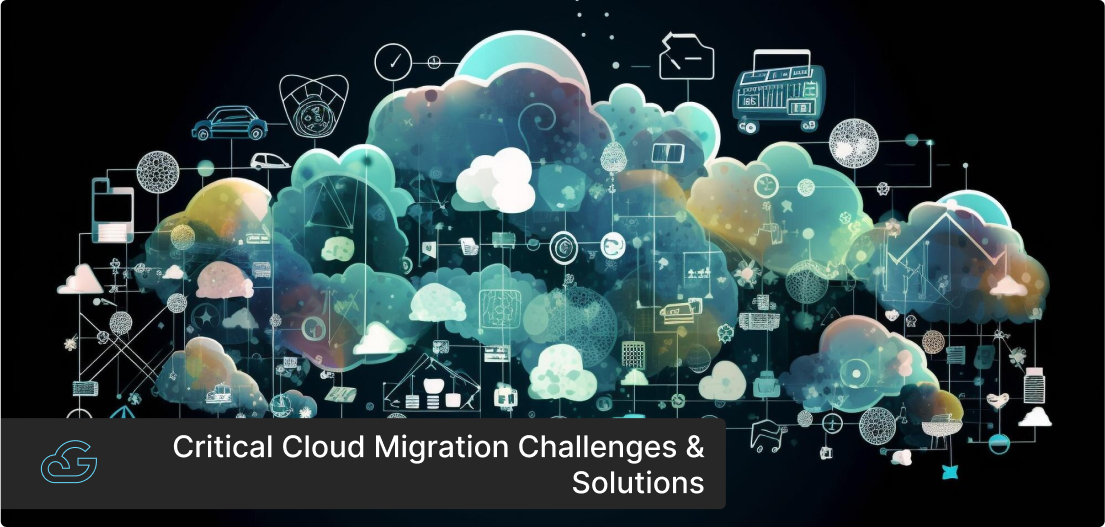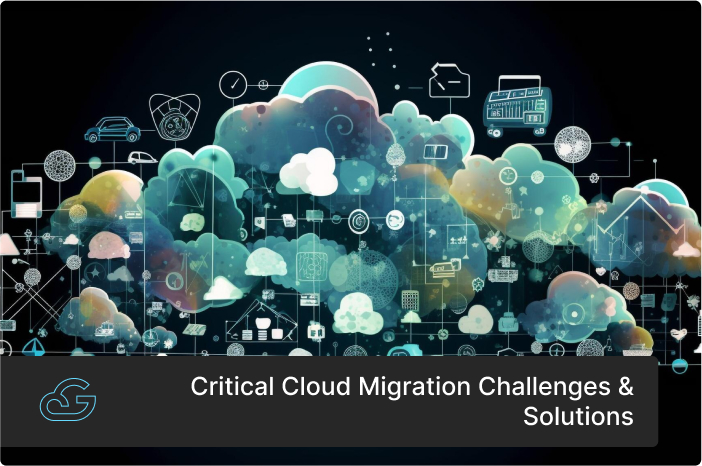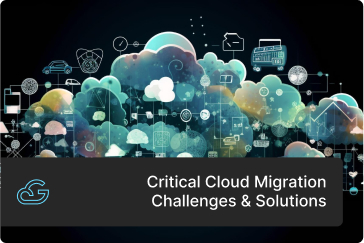Blogs / Cloud Migration
Identifying the Critical Challenges & Solutions in Cloud Migration
By
Sherin Job Varghese
Posted: April 2nd, 2023
• 7 minutes and 20 seconds
According to a survey conducted by the Infosys Knowledge Institute, companies that migrated at least 60% of their IT operations and systems to the cloud were able to witness 11.2% profit growth year over year.
While the benefits of cloud migration are undeniable, it is crucial to acknowledge the potential challenges in this transformative journey. Even though the advantages may outweigh the challenges, ignoring or underestimating them can have severe consequences.
In this blog post, we aim to shed light on the most critical challenges you might encounter during cloud migration while providing practical solutions to overcome them. By understanding them, you can make informed decisions, implement robust mitigation strategies, and embark on your cloud migration journey with confidence.
Critical Cloud Migration Challenges and How to Solve Them
-
Ensuring Data Security
As you migrate your data and applications from an on-prem environment to a cloud-based one, you need to be extremely wary of security risks. On-prem environments often come with inbuilt mechanisms to ensure user data is always protected and to ward off data breach attempts by threat actors or cybercriminals.
But while migrating to the cloud, there are high chances of security vulnerabilities as applications and data move through different intermediate stages. During these intermediate stages, anything from insecure APIs and misconfigured servers to issues on the cloud provider’s side and accidental errors might expose your data and applications to attacks.
What You Can Do:
- Incorporate strong encryption for data at rest and in transit.
- Adopt a zero-trust model.
- Use strict access controls and multi-factor authentication.
- Review and update cloud security configurations and policies regularly.
- Leverage the cloud provider’s native security tools and services.
-
Adhering to Regulatory Standards
In recent years, the topic of data privacy has gained unprecedented importance. Customers are extremely concerned about their privacy, and as a result, various government bodies have set up strict regulatory frameworks (GDPR, HIPAA, PCI DSS, etc.) to prevent the misuse of personal data. Ensuring compliance with these necessary regulatory standards during cloud migration poses a significant challenge.
For instance, let’s consider the GDPR framework that deals with EU citizen data. For GDPR compliance, the bylaws state that you must obtain consent while collecting user data, promptly notify users about data breach incidents, enable data access and deletion, etc. You must ensure that the cloud platform you have selected for migration comes with provisions that support these bylaws.
What You Can Do:
- Assess applicable data privacy regulations and compliance requirements.
- Select a cloud service provider that offers robust compliance certifications and built-in data privacy controls.
- Implement data protection techniques, such as encryption, data masking, and redaction, during and after migration.
- Maintain detailed audit trails, logs, and documentation.
- Regularly review and update your data privacy and compliance policies, procedures, and controls.
-
Overcoming Vendor Lock-In
Vendor lock-in is one of the most common problems associated with cloud migration. If you don’t have enough technical expertise to design complex cloud architectures comprising different cloud vendors, you might end up relying on a single cloud service provider. Even though this might seem like the best option in front of you at the onset, the problems will start becoming evident post-migration.
As your business requirements evolve, you may find that the vendor’s service quality declines, their pricing models become less favorable, or certain aspects of your workloads and applications perform better on another vendor’s platform. However, by then, you may have heavily invested in the initial vendor’s proprietary tools, services, and configurations, making it extremely challenging and costly to migrate to a different provider or back to an on-premises environment.
What You Can Do:
- Adopt a multi-cloud or hybrid cloud strategy.
- Use cloud-agnostic tools and technologies to facilitate portability.
- Regularly evaluate and compare cloud providers’ offerings and pricing.
- Implement abstraction layers and containerization to reduce dependencies.
-
Complexities Around Legacy Infrastructure
From a purely technical point of view, one of the key challenges that you might face during cloud migration is your legacy IT architecture. There is a high chance that your existing systems and applications were never designed to interact with modern cloud environments in the first place.
While simple “lift and shift” migrations, where applications are simply moved to cloud-hosted environments without any modifications, may seem appealing, they often prove impractical when it comes to legacy infrastructure. These applications were built with on-prem constraints in mind, which makes them ill-suited for the cloud’s scalable and distributed nature.
What You Can Do:
- Conduct extensive compatibility assessments.
- Select the right cloud migration approach.
- Resolve the technical debt.
- Figure out the interdependent elements.
- Collaborate with vendors who specialize in migrating legacy systems.
-
Preventing Data Loss
Data migration is one of the most complex and risky phases of your cloud journey. You will have to deal with large volumes of structured and unstructured data. It will include databases, files, applications, email archives, multimedia assets, and much more.
All this data will undergo multiple stages of extraction, transformation, and loading, which often involve temporary storage systems, format conversions, and integrations with new platforms and systems. Each of these stages and elements can introduce vulnerabilities that could result in data corruption, deletion, or misplacement.
Moreover, the decoupled nature of cloud environments, along with the involvement of third-party services and APIs, create an added layer of complexity. This results in issues such as network disruptions, API incompatibilities, or misconfigurations, leading to data loss or inconsistencies.
What You Can Do:
- Implement robust data backup and disaster recovery mechanisms.
- Conduct thorough data profiling, mapping, and validation.
- Leverage the cloud provider’s data migration tools.
- Conduct extensive testing of the migration process.
- Move data into smaller, manageable chunks.
- Set up failover mechanisms and rollback procedures.
-
Overcoming Cultural Resistance
Migrating to the cloud can almost feel like hitting the reset button. Especially for your employees and other stakeholders who were used to the legacy systems and applications, this move can be a radical change. And it is natural that you will face some form of resistance from them.
Cloud migration is about embracing a significant shift in mindset, processes, and ways of working. It requires adapting new approaches, such as cloud-based DevOps automation, which can be overwhelming for teams that have traditionally operated in a more siloed and manual environment. On top of these, the perceived risks of cloud adoption, like security concerns, loss of control, and job uncertainty, can also fuel resistance and skepticism.
What You Can Do:
- Clearly communicate the strategic benefits and competitive advantages of cloud migration to all stakeholders.
- Invest in upskilling and reskilling programs to equip your workforce with the necessary cloud skills.
- Engage stakeholders proactively and address their concerns transparently.
- Emphasize the strategic importance of cloud migration for the organization's long-term growth.
- Implement change management strategies.
-
Hidden Cloud Costs
While cloud migration can ultimately offer you cost savings, it is important to remember that there are hidden costs associated with the entire process. If not monitored and managed properly, these costs can spiral out of control, straining your organization’s budget.
Cloud costs can stem from numerous factors, but one of the primary sources is the complexity of cloud pricing models. Cloud providers offer a vast array of services, each with its own pricing structure based on factors such as resource consumption, data transfer, and storage requirements. Without careful monitoring and optimization, these costs can quickly escalate, especially as your cloud footprint grows and workloads become more distributed.
Furthermore, there are ancillary costs associated with cloud migration. This includes training and upskilling costs for staff members, customization costs, licensing fees, data transfer costs, and more.
What You Can Do:
- Implement cloud FinOps practices to gain visibility into cloud spending.
- Conduct regular cost analysis and forecasting to identify cost drivers.
- Carefully evaluate and select cloud providers.
- Leverage cost management tools and services.
- Optimize cloud infrastructure and architecture by leveraging auto-scaling, rightsizing resources, and adopting cost-effective storage and networking solutions.
Why Does Every Business Need Cloud Readiness Assessment Before Migration.
Ultimate Guide to Cloud Migration: Cloud Migration Benefits, Types, Strategies, Best Practices & the Process
Gsoft Cloud: Experience Seamless Cloud Migration
At Gsoft Cloud, we understand that cloud migration is riddled with numerous risks and challenges that can derail your cloud journey. It can be daunting to tackle all these challenges alone. That’s why we offer managed cloud migration services and solutions to mitigate these risks and ensure a seamless transition to the cloud.
Our expertise spans:
- Cloud readiness assessment and strategy formulation
- Security evaluations and implementation
- Eliminating hidden cloud costs
- Privacy control integrations and compliance assessments
- Multi-cloud and hybrid cloud architecture designs
- Application modernization and refactoring services
- Data backup, validation, and failover mechanisms
- Proactive Monitoring
Summary:
In today’s dynamic digital ecosystem, it is absolutely vital that you embrace a cloud-first approach. While legacy systems provide several benefits, the cloud enables you to respond faster to evolving market conditions cost-effectively. Cloud migration is the first step towards that. Though it is a seemingly straightforward process, it requires incredible technical prowess and deep knowledge of cloud computing platforms. Therefore, if you do not have the required technical capability in-house, you must always look for a cloud partner who can help before initiating your cloud migration project.
Are you looking for a cloud partner to kickstart your cloud migration project? Reach out to us at www.gsoftcomm.net/contact-us.


Get Know More About Our Services and Products
Reach to us if you have any queries on any of our products or Services.











